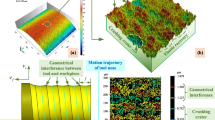Abstract
Ceramic materials are finished primarily by abrasive machining processes such as grinding, lapping, and polishing. In grinding, the abrasives typically are bonded in a grinding wheel and brought into contact with the ceramic surface at relatively high sliding speeds. In lapping and polishing, the ceramic is pressed against a polishing block with the abrasives suspended in between them in the form of a slurry. The material removal process here resembles three-body wear. In all these processes, the mechanical action of the abrasive can be thought of as the repeated application of relatively sharp sliding indenters to the ceramic surface. Under these conditions, a small number of mechanisms dominate the material removal process. These are brittle fracture due to crack systems oriented both parallel (lateral) and perpendicular (radial/median) to the free surface, ductile cutting with the formation of thin ribbon-like chips, and chemically assisted wear in the presence of a reactant that is enhanced by the mechanical action (tribochemical reaction). The relative role of each of these mechanisms in a particular finishing process can be related to the load applied to an abrasive particle, the sliding speed of the particle, and the presence of a chemical reactant. These wear mechanisms also cause damage to the near ceramic surface in the form of microcracking, residual stress, plastic deformation, and surface roughness which together determine the strength and performance of the finished component. A complete understanding of the wear mechanisms leading to material removal would allow for the design of efficient machining processes for producing ceramic surfaces of high quality.
Similar content being viewed by others
References
Ahn Y, Farris T N, Chandrasekar S 1993 Elastic stress fields caused by sliding microindentation of brittle materials. InMachining of advanced materials. NIST SP 847 (ed.) S Jahanmir, pp 71–81
Braza J F, Cheng H S, Fine M E, Gangopadhyay A K, Keer L, Worden R E 1989 Mechanical failure mechanisms in ceramic sliding and rolling contacts.Tribol. Trans. 32: 1–8
Broese van Groenou A, Maan N, Veldkamp J B D 1979 Single-point scratches as a basis for understanding grinding and lapping. InThe science of ceramic machining and surface finishing (eds) B J Hockey, R W Rice, NBS SP 562, vol. 2, pp 43–60
Chandrasekar S, Farris T N, Shaw M C, Bhushan B 1991 Surface finishing processes for magnetic recording head ceramics.ASME Adv. Information Storage Systems 1 (1): 353–373
Chauhan R, Ahn Y, Chandrasekar S, Farris T N 1993 Role of indentation fracture in free abrasive machining of ceramics.Wear 162: 246–257
Cheng W, Finnie I 1990 A mechanism for sub-surface median crack initiation in glass during indenting and scribing.J. Mater. Sci. 25: 575–579
Evans A G, Marshall D B 1981 Wear mechanisms in ceramics. InFundamentals of friction and wear of materials (ed.) D A Rigney (ASM) pp 439–452
Hebbar R R, Chandrasekar S, Farris T N 1992 Ceramic grinding temperatures.J. Am. Ceram. Soc. 75: 2742–2748
Hucker S A, Farris T N, Chandrasekar S 1994 Technique for measuring dynamic grinding contact stiffness and effective wheel modulus.J. Tribol. (submitted)
Jahanmir S, Dong X 1994 Wear mechanisms of aluminum oxide ceramics. InFriction and wear of ceramics (Marcel Dekker) pp 15–49
Jahanmir S, Ives L K, Ruff A W, Peterson M B 1992 Ceramic machining: Assessment of current practice and research needs in the United States. Technical report, NIST SP 834
Larsen Basse J 1994 Abrasive wear of ceramics. InFriction and wear of ceramics (ed.) S Jahanmir (Marcel Dekker) pp 99–115
Lu L, Farris T N, Chandrasekar S 1992 Sliding microindentation wear particles: Spheres in grinding swarf. InFrom the cradle to the grave (eds) D Dowson, C M Taylor, T H C Childs, M Godet, G Dalmaz (Elsevier) pp 257–263
Marshall D B, Evans A G, Khuri-Yakub B T, Tien J W, Kino G S 1983 The nature of machining damage in brittle materials.Proc. R. Soc. A385: 461–475
Stokes R J 1972 The effect of surface finishing on mechanical and other physical properties of ceramics. InThe science of ceramic machining and surface finishing (eds) R W Rice, S J Schneider, NBS SP 348, pp 343–353
Subramanian K 1988 Precision finishing of ceramic components with diamond abrasives.Am. Ceram. Soc. Bull. 67: 1026–1029
Swain M V 1979 Microfracture about scratches in brittle solids.Proc. R. Soc. A366: 575–597
Yoffe E H 1982 Elastic stress fields caused by indenting brittle materials.Philos. Mag. A46: 617–628
Author information
Authors and Affiliations
Corresponding author
Additional information
The research was supported in part by the National Science Foundation through grants MSS 9057082, Jorn Larsen-Basse, Program Director and DDM 9057916, Bruce Kramer, Program Director.
Rights and permissions
About this article
Cite this article
Chandrasekar, S., Farris, T.N. Machining and surface finishing of brittle solids. Sadhana 22, 473–481 (1997). https://doi.org/10.1007/BF02744484
Issue Date:
DOI: https://doi.org/10.1007/BF02744484




